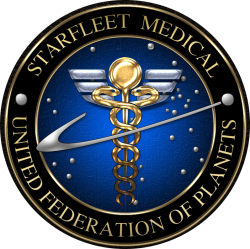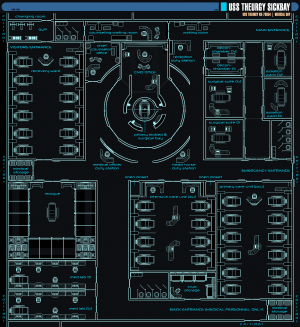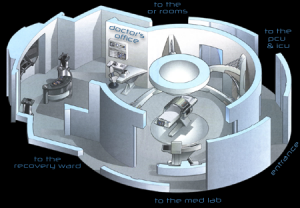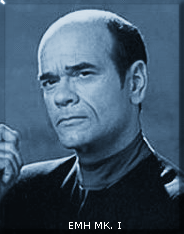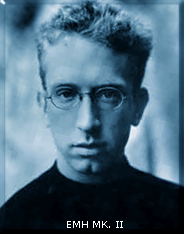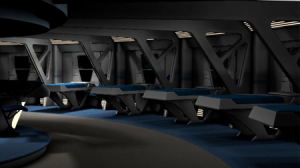Medical: Difference between revisions
From Star Trek: Theurgy Wiki
Auctor Lucan (talk | contribs) |
No edit summary |
||
| Line 1: | Line 1: | ||
[[File:Starfleet Medical.png|right|250px]][[Starfleet]] '''Medical''' was a department composed of officers and crewmen trained to maintain and treat the crew's physical and psychological conditions, however, there were also several investigative members working in the research area. | [[File:Starfleet Medical.png|right|250px]][[Starfleet]] '''Medical''' was a department composed of officers and crewmen trained to maintain and treat the crew's physical and psychological conditions, however, there were also several investigative members working in the research area. | ||
Based out of San Francisco on Earth, [[Starfleet Medical]] oversaw all [[Starfleet Medical|Starfleet medical]] personnel and facilities, which included exercising co-authority, besides the captain, over starship sickbay personnel. As its emblem, the department carried, from the mid-2150s onward, a stylized version of the double-snaked medical caduceus symbol from ancient Greek mythology. With the launch of the NX-class, [[Starfleet Medical]] asserted its co-authority over sickbay, by having its symbol prominently featured on the transparent access doors to sickbay, something repeated two centuries later with the Galaxy-class. In the 2270s and the 2280s (when the emblem was shortly replaced with a variant design), the emblem was worn by starship medical personnel on their garments | Based out of San Francisco on Earth, [[Starfleet Medical]] oversaw all [[Starfleet Medical|Starfleet medical]] personnel and facilities, which included exercising co-authority, besides the captain, over starship sickbay personnel. As its emblem, the department carried, from the mid-2150s onward, a stylized version of the double-snaked medical caduceus symbol from ancient Greek mythology. With the launch of the NX-class, [[Starfleet Medical]] asserted its co-authority over sickbay, by having its symbol prominently featured on the transparent access doors to sickbay, something repeated two centuries later with the Galaxy-class. In the 2270s and the 2280s (when the emblem was shortly replaced with a variant design), the emblem was worn by starship medical personnel on their garments when on duty in sickbay. [http://memory-alpha.wikia.com/wiki/Starfleet_Medical Source: Memory Alpha] | ||
== Medical Equipment == | == Medical Equipment == | ||
==== Autosuture==== | ==== Autosuture==== | ||
An autosuture was a handheld unit used to heal reasonably mild wounds to the skin. Autosutures can be used to close incisions or heal knife wounds beyond the ability of a dermal regenerator. In 2369 an autosuture was used to heal a stab wound received by Captain Jean Luc Picard. | An autosuture was a handheld unit used to heal reasonably mild wounds to the skin. Autosutures can be used to close incisions or heal knife wounds beyond the ability of a dermal regenerator. In 2369, an autosuture was used to heal a stab wound received by Captain Jean Luc Picard. | ||
==== Biobed==== | ==== Biobed==== | ||
| Line 11: | Line 11: | ||
==== Brain-circuitry Pattern==== | ==== Brain-circuitry Pattern==== | ||
The brain-circuitry pattern was used as both a medical diagnostic tool as well as a means of identification as such patterns | The brain-circuitry pattern was used as both a medical diagnostic tool as well as a means of identification as such patterns were unique to that individual. The scan created an image capable of mapping the neural activity in the brain. | ||
==== Cardio-Inducer==== | ==== Cardio-Inducer==== | ||
| Line 17: | Line 17: | ||
==== Cortical Stimulator==== | ==== Cortical Stimulator==== | ||
Cortical stimulators helped return the brain and nervous system to a normal, healthy state when a humanoid | Cortical stimulators helped return the brain and nervous system to a normal, healthy state when a humanoid entered a coma or suffered other forms of serious neurological disturbance. | ||
During treatment doctors placed the unit on the patient's head. The stimulator's linear array of electromyonic sensors analysed the current level of neural activity and compared this activity to the normal parameters for the patient's species. Using these readings the physician then activated the stimulator's network of phased muon projectors. Intersecting muon beams focused on individual neurons, stimulating them in patterns similar to normal brain activity. A sufficient level of neural stimulation usually resulted in the patient's other neurons adapting their firing to match this pattern, returning the patient to a normal state. | During treatment, doctors placed the unit on the patient's head. The stimulator's linear array of electromyonic sensors analysed the current level of neural activity and compared this activity to the normal parameters for the patient's species. Using these readings, the physician then activated the stimulator's network of phased muon projectors. Intersecting muon beams focused on individual neurons, stimulating them in patterns similar to normal brain activity. A sufficient level of neural stimulation usually resulted in the patient's other neurons adapting their firing to match this pattern, returning the patient to a normal state. | ||
Doctors would carefully monitor the cortical stimulator or the patient could experience neural damage or seizures. In the hands of a skilled physician this device could even help cure complex neurological abnormalities like the [[Vulcan]] t'lokan schism or temporary insanity induced by drugs or stress. Doctors had occasionally used this device to reinforce normal neurological patterns to such a degree that noncorporeal beings inhabiting patients were expelled. On rare occasions when a patient's bioneural energy was temporarily displaced from the body, a cortical stimulator could keep the patient's body alive until this energy was returned. | Doctors would carefully monitor the cortical stimulator or the patient could experience neural damage or seizures. In the hands of a skilled physician this device could even help cure complex neurological abnormalities like the [[Vulcan]] t'lokan schism or temporary insanity induced by drugs or stress. Doctors had occasionally used this device to reinforce normal neurological patterns to such a degree that noncorporeal beings inhabiting patients were expelled. On rare occasions when a patient's bioneural energy was temporarily displaced from the body, a cortical stimulator could keep the patient's body alive until this energy was returned. | ||
| Line 26: | Line 26: | ||
Physicians throughout the [[Federation]] used delta wave inducers to help patients enter a deep and restful sleep. [[Starfleet]] cadets and other students sometimes used inducers to get to sleep before an important performance review. Most humanoid brains oscillated in a certain range of resonance frequencies (known as delta waves) while asleep; this device artificially induced this state and eased the subject into sleep. | Physicians throughout the [[Federation]] used delta wave inducers to help patients enter a deep and restful sleep. [[Starfleet]] cadets and other students sometimes used inducers to get to sleep before an important performance review. Most humanoid brains oscillated in a certain range of resonance frequencies (known as delta waves) while asleep; this device artificially induced this state and eased the subject into sleep. | ||
The delta wave inducer was a partial headband that fit comfortably over the user's forehead and temples. The device activated a series of superconducting nickel-rhombium zeta-meson projectors. The zeta-meson fields produced by the delta wave inducer oscillated in the same frequency as delta waves, and caused the neurons in the user's brain to fire in a similar pattern through mesonic induction. Within five minutes of activation the user fell into a sound sleep. Normally the unit turned itself off after ten minutes, although a physician could program it to keep the user asleep for a set period of time, waking him up by damping out the delta waves in his brain. Doctors advised healthy subjects who simply needed help getting to sleep not to use this unit more than twice a week to avoid psychological dependence. | The delta wave inducer was a partial headband that fit comfortably over the user's forehead and temples. The device activated a series of superconducting nickel-rhombium zeta-meson projectors. The zeta-meson fields produced by the delta wave inducer oscillated in the same frequency as delta waves, and caused the neurons in the user's brain to fire in a similar pattern through mesonic induction. Within five minutes of activation, the user fell into a sound sleep. Normally, the unit turned itself off after ten minutes, although a physician could program it to keep the user asleep for a set period of time, waking him up by damping out the delta waves in his brain. Doctors advised healthy subjects who simply needed help getting to sleep not to use this unit more than twice a week to avoid psychological dependence. | ||
==== Dermal Regenerator==== | ==== Dermal Regenerator==== | ||
| Line 37: | Line 37: | ||
Sometimes internal injuries or the presence of foreign bodies inside the patient required physicians to perform surgery. Based on principles similar to those used by multipurpose gravitonic effectors, exoscalpels were the 24th century surgical cutting device. This unit used trionic emitters to tightly focus a low-powered rapid nadion cutting beam. | Sometimes internal injuries or the presence of foreign bodies inside the patient required physicians to perform surgery. Based on principles similar to those used by multipurpose gravitonic effectors, exoscalpels were the 24th century surgical cutting device. This unit used trionic emitters to tightly focus a low-powered rapid nadion cutting beam. | ||
Exoscalpels had two modes of operation. In the normal mode a exoscalpel projected a linear nadion beam that functioned as an exceedingly thin blade. A surgeon could focus the beam as short as 0.1 cm or as long as 20 cm for exceptionally deep incisions. The trionic emitters could also focus the nadions at certain points along the beam. Since only focused nadions could slice tissue, a exoscalpel could cut deeply within a patient without actually piercing the skin or damaging any tissue between the exoscalpel and the affected region. This focused cutting area could extend up to 20 cm away from the unit and could focus as short as 0.1 cm or as long as 5 cm. If the surgical procedure required it, a strong electric charge carried by the trionic beam could instantly cauterize any incision this device made. | Exoscalpels had two modes of operation. In the normal mode, a exoscalpel projected a linear nadion beam that functioned as an exceedingly thin blade. A surgeon could focus the beam as short as 0.1 cm or as long as 20 cm for exceptionally deep incisions. The trionic emitters could also focus the nadions at certain points along the beam. Since only focused nadions could slice tissue, a exoscalpel could cut deeply within a patient without actually piercing the skin or damaging any tissue between the exoscalpel and the affected region. This focused cutting area could extend up to 20 cm away from the unit and could focus as short as 0.1 cm or as long as 5 cm. If the surgical procedure required it, a strong electric charge carried by the trionic beam could instantly cauterize any incision this device made. | ||
Like many instruments, exoscalpels had alternate uses. While this device was incapable of affecting refractory materials like tritanium or Duranium, an exoscalpel could easily cut all ordinary organic material like wood or bone, and most of the boronite whisker composites used in furniture and clothing. | Like many instruments, exoscalpels had alternate uses. While this device was incapable of affecting refractory materials like tritanium or Duranium, an exoscalpel could easily cut all ordinary organic material like wood or bone, and most of the boronite whisker composites used in furniture and clothing. | ||
| Line 55: | Line 55: | ||
==== Medical Kit==== | ==== Medical Kit==== | ||
Medkits, also known as medikits, were pouches used by [[Starfleet Medical|Starfleet medical]] practitioners and officers that contained medical equipment for away teams, containing a medical tricorder, a hypospray, a dermal regenerator, and a trauma kit for emergency medical situations. They were often kept in strategic positions around [[Starfleet]] vessels and bases. | Medkits, also known as medikits, were pouches used by [[Starfleet Medical|Starfleet medical]] practitioners and officers that contained medical equipment for away teams, containing a medical [[tricorder]], a hypospray, a dermal regenerator, and a trauma kit for emergency medical situations. They were often kept in strategic positions around [[Starfleet]] vessels and bases. | ||
==== Medical tricorder==== | ==== Medical tricorder==== | ||
The medical tricorder was a specialized version of the standard tricorder. It was equipped with sensors and analysis software tailored for medical diagnostic purposes. They were usually the first tool a [[Starfleet]] doctor utilized when assessing a patient's condition. Medical tricorders could function aboard ship in sickbay as well as on away missions. | The medical [[tricorder]] was a specialized version of the standard [[tricorder]]. It was equipped with sensors and analysis software tailored for medical diagnostic purposes. They were usually the first tool a [[Starfleet]] doctor utilized when assessing a patient's condition. Medical tricorders could function aboard ship in sickbay as well as on away missions. | ||
==== Micro-Tone==== | ==== Micro-Tone==== | ||
| Line 79: | Line 79: | ||
==== Psychotricorder==== | ==== Psychotricorder==== | ||
A psychotricorder was a [[Federation]] instrument, similar to a tricorder, used to record past memories. | A psychotricorder was a [[Federation]] instrument, similar to a [[tricorder]], used to record past memories. | ||
==== Retinal Imaging Scan==== | ==== Retinal Imaging Scan==== | ||
| Line 85: | Line 85: | ||
==== Sonic Separator==== | ==== Sonic Separator==== | ||
The sonic | The sonic separator was a medical instrument commonly used to separate tissue, similar to a laser scalpel. | ||
==== Surgical Support Frame==== | ==== Surgical Support Frame==== | ||
| Line 92: | Line 92: | ||
The SSF was capable of automated administration of intravenous medication as well as cardiovascular support and emergency defibrillation. | The SSF was capable of automated administration of intravenous medication as well as cardiovascular support and emergency defibrillation. | ||
There were a variety of support frame types for different procedures and different body lifeform types. They | There were a variety of support frame types for different procedures and different body lifeform types. They were integral parts of any Surgical Bay. | ||
==== Tissue Scanner==== | ==== Tissue Scanner==== | ||
| Line 104: | Line 104: | ||
== ''[[USS Theurgy]]'' Sickbay == | == ''[[USS Theurgy]]'' Sickbay == | ||
Sickbay was an old Navy term for "ship's hospital", which | Sickbay was an old Navy term for "ship's hospital", which continued even into the 24th Century. | ||
[[File:Star_trek__theurgy___fleet_capacity_sickbay_by_auctor_lucan-d8dm2bv.png|right|thumbnail|USS Theurgy Main Sickbay]] | [[File:Star_trek__theurgy___fleet_capacity_sickbay_by_auctor_lucan-d8dm2bv.png|right|thumbnail|USS Theurgy Main Sickbay]] | ||
| Line 118: | Line 118: | ||
==== Recovery Ward ==== | ==== Recovery Ward ==== | ||
Pretty much where you' | Pretty much where you'd end up if your illness or injury was not too life-threatening but the doctor required you to hang around overnight for treatment and/or monitoring. Also was where non-critical patients were placed after surgery. Included 12 biobeds with overhead monitors, sanitized pillows and sheets for each bed, 1 replicator, and supply storage cabinet close by. | ||
==== Primary Care Unit [PCU] ==== | ==== Primary Care Unit [PCU] ==== | ||
This | This was most likely where you'd be treated for bumps, bruises, common diseases, and anything else that didn't look to be particularly life-threatening. Included 12 scanning biobeds. | ||
==== Intensive Care Unit [ICU] ==== | ==== Intensive Care Unit [ICU] ==== | ||
Here's where you go if the doctors | Here's where you'd go if the doctors weren't sure whether you'd die soon or not and there was little more they could do about it but watch and wait. Each biobed was rigged for constant 3-dimensional scanning and monitoring of the patient. Included a computer link-up to an adjustable "Code Blue" alarm system that sounded the instant a patient's life-signs fell out of acceptable parameters. Also included 1 replicator, additional life support hardware for each bed, back-up battery power on a separate power grid from the ship, atmospheric isolation systems, and a supply storage closet that could be found near by. | ||
==== Medlab 01 ==== | ==== Medlab 01 ==== | ||
The primary laboratory for Sickbay's use. | The primary laboratory for Sickbay's use. Included 1 replicator, material diagnostics stations, a centrifuge, gene analysis terminal, a table for post-mortum examinations, and stasis field drawers for storage of biological samples, corpses, or patients requiring treatment not available on the ship. [Also Medlab 02] | ||
==== Surgical Suite 01 ==== | ==== Surgical Suite 01 ==== | ||
If you | If you needed surgery to save your life, correct an illness, fix a serious injury, or to just have yourself cosmetically altered for an undercover assignment this was where they'd have you laid out. Along with the usual surgical tools, the room included mobile life support equipment, a replicator, atmospheric isolation systems, and scanning/monitoring readout station. | ||
[Also Surgical Suite 02] | [Also Surgical Suite 02] | ||
| Line 139: | Line 139: | ||
|} | |} | ||
Two EMH programs | Two EMH programs were available, the longer term Mark II and the short term Mark I. Developed to act as the Chief Medical Officer as and when required, these programs could also be activated to provide additional assistance to the real Chief Medical Officer. The EMH were programmed with all current medical knowledge and had the ability to learn as required. Additionally, the EMH could take on any other medical role as required by the ship/facility. | ||
Unlike previous EMH systems with primary emitters inset into ceiling every 1.5 meters and larger back-up emitters inset into | Unlike previous EMH systems with primary emitters inset into the ceiling every 1.5 meters and larger back-up emitters inset into center of each ceiling over the Recovery Ward, Primary Care Unit, Medlab-1, and both operating rooms being fully integrated with Sickbay's computer hardware to prevent accidental loss of the EMH at critical moments, the [[Theurgy-class]] took the EMH one step further, having holo-emitters in every area of the ship, allowing the good doctors to venture outside of Sickbay to treat the wounded more efficiently just like the Ship AI Hologram. | ||
=== Battle Sickbays === | === Battle Sickbays === | ||
Because of the Theurgy's MVAM-mode, many main areas of the ship | Because of the Theurgy's MVAM-mode, many main areas of the ship were duplicated, this included the Sickbay. Vector 02 and 03 sections both contained a full Sickbay. Vector 01's Sickbay (the saucer section) was the Main Sickbay area [discussed above], while the other two Vectors had one Battle Sickbay each. These were much larger than the Main Sickbay, and with its open layout that gave the medical personnel more freedom of moment, they were designed specifically for battle conditions. | ||
[[File:Battle_sickbay_by_auctor_lucan-d8e64yz.png|left|thumbnail|Battle Sickbay]] | [[File:Battle_sickbay_by_auctor_lucan-d8e64yz.png|left|thumbnail|Battle Sickbay]] | ||
Revision as of 17:08, 28 February 2017
Starfleet Medical was a department composed of officers and crewmen trained to maintain and treat the crew's physical and psychological conditions, however, there were also several investigative members working in the research area.
Based out of San Francisco on Earth, Starfleet Medical oversaw all Starfleet medical personnel and facilities, which included exercising co-authority, besides the captain, over starship sickbay personnel. As its emblem, the department carried, from the mid-2150s onward, a stylized version of the double-snaked medical caduceus symbol from ancient Greek mythology. With the launch of the NX-class, Starfleet Medical asserted its co-authority over sickbay, by having its symbol prominently featured on the transparent access doors to sickbay, something repeated two centuries later with the Galaxy-class. In the 2270s and the 2280s (when the emblem was shortly replaced with a variant design), the emblem was worn by starship medical personnel on their garments when on duty in sickbay. Source: Memory Alpha
Medical Equipment
Autosuture
An autosuture was a handheld unit used to heal reasonably mild wounds to the skin. Autosutures can be used to close incisions or heal knife wounds beyond the ability of a dermal regenerator. In 2369, an autosuture was used to heal a stab wound received by Captain Jean Luc Picard.
Biobed
The primary biobed in sickbay was designed for surgical purposes, although it was also the default bed for examinations conducted by medical personnel. It had various hookups for surgical equipment, and was typically covered by a large sensor cluster. Surgical beds usually had a large display for vital signs and other information adjacent to the bed. Serious surgeries usually required a larger biobed with more specialized sensors and surgical equipment.
Brain-circuitry Pattern
The brain-circuitry pattern was used as both a medical diagnostic tool as well as a means of identification as such patterns were unique to that individual. The scan created an image capable of mapping the neural activity in the brain.
Cardio-Inducer
The cardio-inducer was a medical device which was used to treat heart conditions in artificial hearts.
Cortical Stimulator
Cortical stimulators helped return the brain and nervous system to a normal, healthy state when a humanoid entered a coma or suffered other forms of serious neurological disturbance.
During treatment, doctors placed the unit on the patient's head. The stimulator's linear array of electromyonic sensors analysed the current level of neural activity and compared this activity to the normal parameters for the patient's species. Using these readings, the physician then activated the stimulator's network of phased muon projectors. Intersecting muon beams focused on individual neurons, stimulating them in patterns similar to normal brain activity. A sufficient level of neural stimulation usually resulted in the patient's other neurons adapting their firing to match this pattern, returning the patient to a normal state.
Doctors would carefully monitor the cortical stimulator or the patient could experience neural damage or seizures. In the hands of a skilled physician this device could even help cure complex neurological abnormalities like the Vulcan t'lokan schism or temporary insanity induced by drugs or stress. Doctors had occasionally used this device to reinforce normal neurological patterns to such a degree that noncorporeal beings inhabiting patients were expelled. On rare occasions when a patient's bioneural energy was temporarily displaced from the body, a cortical stimulator could keep the patient's body alive until this energy was returned.
Delta Wave Inducer
Physicians throughout the Federation used delta wave inducers to help patients enter a deep and restful sleep. Starfleet cadets and other students sometimes used inducers to get to sleep before an important performance review. Most humanoid brains oscillated in a certain range of resonance frequencies (known as delta waves) while asleep; this device artificially induced this state and eased the subject into sleep.
The delta wave inducer was a partial headband that fit comfortably over the user's forehead and temples. The device activated a series of superconducting nickel-rhombium zeta-meson projectors. The zeta-meson fields produced by the delta wave inducer oscillated in the same frequency as delta waves, and caused the neurons in the user's brain to fire in a similar pattern through mesonic induction. Within five minutes of activation, the user fell into a sound sleep. Normally, the unit turned itself off after ten minutes, although a physician could program it to keep the user asleep for a set period of time, waking him up by damping out the delta waves in his brain. Doctors advised healthy subjects who simply needed help getting to sleep not to use this unit more than twice a week to avoid psychological dependence.
Dermal Regenerator
A dermal regenerator was a common medical device used to heal minor wounds although major, gaping wounds and surgical incisions still required an autosuture. The dermal regenerator could also be used for cosmetic surgery such as removing scars as well as removing disguises created through the use of synthetic skin.
DNA Reference Scan
A DNA Reference Scan was a medical procedure to identify an individual by matching the DNA patterns with those on file.
Exoscalpel
Sometimes internal injuries or the presence of foreign bodies inside the patient required physicians to perform surgery. Based on principles similar to those used by multipurpose gravitonic effectors, exoscalpels were the 24th century surgical cutting device. This unit used trionic emitters to tightly focus a low-powered rapid nadion cutting beam.
Exoscalpels had two modes of operation. In the normal mode, a exoscalpel projected a linear nadion beam that functioned as an exceedingly thin blade. A surgeon could focus the beam as short as 0.1 cm or as long as 20 cm for exceptionally deep incisions. The trionic emitters could also focus the nadions at certain points along the beam. Since only focused nadions could slice tissue, a exoscalpel could cut deeply within a patient without actually piercing the skin or damaging any tissue between the exoscalpel and the affected region. This focused cutting area could extend up to 20 cm away from the unit and could focus as short as 0.1 cm or as long as 5 cm. If the surgical procedure required it, a strong electric charge carried by the trionic beam could instantly cauterize any incision this device made.
Like many instruments, exoscalpels had alternate uses. While this device was incapable of affecting refractory materials like tritanium or Duranium, an exoscalpel could easily cut all ordinary organic material like wood or bone, and most of the boronite whisker composites used in furniture and clothing.
Hyperencephalogram
A hyperencephalogram was a medical test involving an instrument capable of recording and measuring brain-wave activity.
Hypospray
A hypospray (colloquially, hypo) was a medical device used to inject liquids into the body. The system used a non-invasive transport mechanism of compressed air to transfer the injectant from the device into the body without the use of a needle, ensuring that the skin was not punctured during use, thus reducing the risk of infection. Various drugs could be used, inserted into the hypo in vials attached to the end of the instrument.
The 23rd century Federation hypospray resembled the intravenous needles of previous centuries, whilst the 24th century version of the device was more compact, employing an angled head and rounded tip to transfer the drug more easily. Controls at the injection head set the dosage to be injected.
The typical injection site used was the side of the neck, but the hypospray could inject even through clothing. Unlike hypodermic needles, the hypospray could be used on multiple patients without worries of spreading blood-borne illnesses.
K-3 Indicator
A K-3 Indicator was a medical diagnostic device on Starfleet biobeds that measured the neural activity which corresponded with the level of pain as it was being experienced by the patient.
Medical Kit
Medkits, also known as medikits, were pouches used by Starfleet medical practitioners and officers that contained medical equipment for away teams, containing a medical tricorder, a hypospray, a dermal regenerator, and a trauma kit for emergency medical situations. They were often kept in strategic positions around Starfleet vessels and bases.
Medical tricorder
The medical tricorder was a specialized version of the standard tricorder. It was equipped with sensors and analysis software tailored for medical diagnostic purposes. They were usually the first tool a Starfleet doctor utilized when assessing a patient's condition. Medical tricorders could function aboard ship in sickbay as well as on away missions.
Micro-Tone
A micro-tone was a device which could be used to make extremely precise cuts, such as trying to sever the spine, where a exoscalpel or sonic separator would create too coarse an incision.
Neural Bridge
The neural bridge was a medical device that could be used to stabilize the neural functions of a patient with heavy brain damage. It allowed the brain of a normal person to be used to support a damaged brain.
Neural Imaging Scan
The neural imaging scan was a medical diagnostic scan employed to test acuity of a patient's visual cortex.
Neural Stimulator
A neural stimulator was a medical instrument used to increase activity in the central nervous system of a dying humanoid brain.
Neural Transducer
Neural transducers were small devices used to restore mobility to physically disabled individuals. They could pick up the neural signals from the brain and then stimulate the appropriate muscles. The implants were generally not one hundred percent effective, but did allow a patient to recover most mobility. Motor assist bands were first used to train the patient's nervous system before surgery.
Optical Scanner
The optical scanner was used to perform diagnostics on the visual receptors by Engineering Officers. It could detect phase variances and alterations in the surrounding dekyon field.
Psychotricorder
A psychotricorder was a Federation instrument, similar to a tricorder, used to record past memories.
Retinal Imaging Scan
A retinal imaging scan enabled the Medical Officer to verify the presence or absence of visual cortex activity.
Sonic Separator
The sonic separator was a medical instrument commonly used to separate tissue, similar to a laser scalpel.
Surgical Support Frame
A key part of any surgical operation was the Surgical Support Frame or SSF, which was an attachable device to a Federation biobed. It was commonly called a "clamshell", given its shape and the fact that it was mounted over a patient during a surgical procedure. The SSF provided both a sterile environment and vital diagnostic and life support tools, such as a defibrillator and a pulmonary scanner. The frame incorporated a battery of bio-function sensors to supplement those of the biobed and overhead sensor clusters.
The SSF was capable of automated administration of intravenous medication as well as cardiovascular support and emergency defibrillation.
There were a variety of support frame types for different procedures and different body lifeform types. They were integral parts of any Surgical Bay.
Tissue Scanner
A tissue scanner was used to measure the rate of cellular decay. It could run scans at the molecular level, and was capable of picking up tetryon particles. The sensitivity could be boosted with an enhanced resolution mode, and could adjust the scan field as needed. The unit interfaced with remote computer systems, which could be used to control all functions.
Trilaser Connector
The Trilaser connector was a medical instrument used to reconnect nerve connections.
Vascular Regenerator
A vascular regenerator was a medical instrument used to repair blood vessels and stop bleeding without invasive surgery.
USS Theurgy Sickbay
Sickbay was an old Navy term for "ship's hospital", which continued even into the 24th Century.
Number of Primary Care Biobeds: 12
Number of Intensive Care Biobeds: 8
Number of Recovery Beds: 12
Number of Surgical Beds: 2
Number of Isolation Units: 2
Number of Decontamination Chambers: 2
Number of Medical Replicators: 7 (1 for each area except for the morgue)
Recovery Ward
Pretty much where you'd end up if your illness or injury was not too life-threatening but the doctor required you to hang around overnight for treatment and/or monitoring. Also was where non-critical patients were placed after surgery. Included 12 biobeds with overhead monitors, sanitized pillows and sheets for each bed, 1 replicator, and supply storage cabinet close by.
Primary Care Unit [PCU]
This was most likely where you'd be treated for bumps, bruises, common diseases, and anything else that didn't look to be particularly life-threatening. Included 12 scanning biobeds.
Intensive Care Unit [ICU]
Here's where you'd go if the doctors weren't sure whether you'd die soon or not and there was little more they could do about it but watch and wait. Each biobed was rigged for constant 3-dimensional scanning and monitoring of the patient. Included a computer link-up to an adjustable "Code Blue" alarm system that sounded the instant a patient's life-signs fell out of acceptable parameters. Also included 1 replicator, additional life support hardware for each bed, back-up battery power on a separate power grid from the ship, atmospheric isolation systems, and a supply storage closet that could be found near by.
Medlab 01
The primary laboratory for Sickbay's use. Included 1 replicator, material diagnostics stations, a centrifuge, gene analysis terminal, a table for post-mortum examinations, and stasis field drawers for storage of biological samples, corpses, or patients requiring treatment not available on the ship. [Also Medlab 02]
Surgical Suite 01
If you needed surgery to save your life, correct an illness, fix a serious injury, or to just have yourself cosmetically altered for an undercover assignment this was where they'd have you laid out. Along with the usual surgical tools, the room included mobile life support equipment, a replicator, atmospheric isolation systems, and scanning/monitoring readout station. [Also Surgical Suite 02]
Holographic Projection Grid
Two EMH programs were available, the longer term Mark II and the short term Mark I. Developed to act as the Chief Medical Officer as and when required, these programs could also be activated to provide additional assistance to the real Chief Medical Officer. The EMH were programmed with all current medical knowledge and had the ability to learn as required. Additionally, the EMH could take on any other medical role as required by the ship/facility.
Unlike previous EMH systems with primary emitters inset into the ceiling every 1.5 meters and larger back-up emitters inset into center of each ceiling over the Recovery Ward, Primary Care Unit, Medlab-1, and both operating rooms being fully integrated with Sickbay's computer hardware to prevent accidental loss of the EMH at critical moments, the Theurgy-class took the EMH one step further, having holo-emitters in every area of the ship, allowing the good doctors to venture outside of Sickbay to treat the wounded more efficiently just like the Ship AI Hologram.
Battle Sickbays
Because of the Theurgy's MVAM-mode, many main areas of the ship were duplicated, this included the Sickbay. Vector 02 and 03 sections both contained a full Sickbay. Vector 01's Sickbay (the saucer section) was the Main Sickbay area [discussed above], while the other two Vectors had one Battle Sickbay each. These were much larger than the Main Sickbay, and with its open layout that gave the medical personnel more freedom of moment, they were designed specifically for battle conditions.
Disclaimer Notice
- Starfleet Medical Emblem used with permission of Gazomg Art - granted Nov 24, 2016
- List of medical instruments used with permission of USS Wolff CO - granted Jan 30, 2017
